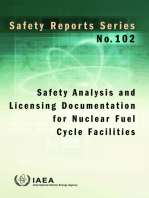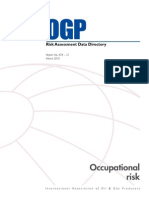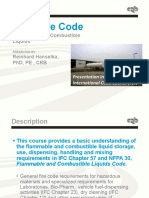434 - Risk Assessment Data Directory PDF
434 - Risk Assessment Data Directory PDF
Uploaded by
Pakorn SangsuraneCopyright:
Available Formats
434 - Risk Assessment Data Directory PDF
434 - Risk Assessment Data Directory PDF
Uploaded by
Pakorn SangsuraneOriginal Title
Copyright
Available Formats
Share this document
Did you find this document useful?
Is this content inappropriate?
Copyright:
Available Formats
434 - Risk Assessment Data Directory PDF
434 - Risk Assessment Data Directory PDF
Uploaded by
Pakorn SangsuraneCopyright:
Available Formats
Risk Assessment Data Directory
Report No. 434 March 2010
Summary
International Association of Oil & Gas Producers
ublications
Global experience
The International Association of Oil & Gas Producers has access to a wealth of technical knowledge and experience with its members operating around the world in many different terrains. We collate and distil this valuable knowledge for the industry to use as guidelines for good practice by individual members.
Consistent high quality database and guidelines
Our overall aim is to ensure a consistent approach to training, management and best practice throughout the world. The oil and gas exploration and production industry recognises the need to develop consistent databases and records in certain fields. The OGPs members are encouraged to use the guidelines as a starting point for their operations or to supplement their own policies and regulations which may apply locally.
Internationally recognised source of industry information
Many of our guidelines have been recognised and used by international authorities and safety and environmental bodies. Requests come from governments and non-government organisations around the world as well as from non-member companies.
Disclaimer
Whilst every effort has been made to ensure the accuracy of the information contained in this publication, neither the OGP nor any of its members past present or future warrants its accuracy or will, regardless of its or their negligence, assume liability for any foreseeable or unforeseeable use made thereof, which liability is hereby excluded. Consequently, such use is at the recipients own risk on the basis that any use by the recipient constitutes agreement to the terms of this disclaimer. The recipient is obliged to inform any subsequent recipient of such terms. This document may provide guidance supplemental to the requirements of local legislation. Nothing herein, however, is intended to replace, amend, supersede or otherwise depart from such requirements. In the event of any conflict or contradiction between the provisions of this document and local legislation, applicable laws shall prevail.
Copyright notice
The contents of these pages are The International Association of Oil and Gas Producers. Permission is given to reproduce this report in whole or in part provided (i) that the copyright of OGP and (ii) the source are acknowledged. All other rights are reserved. Any other use requires the prior written permission of the OGP. These Terms and Conditions shall be governed by and construed in accordance with the laws of England and Wales. Disputes arising here from shall be exclusively subject to the jurisdiction of the courts of England and Wales.
Risk Aassessment data directory summary
Background
At the end of 1996, the E&P Forum (the previous name of OGP) completed and issued the Risk Assessment Data Directory. Its aim was to provide a catalogue of information that could be used to improve the quality and consistency of risk assessments with readily available benchmark data and references for common types of incident analysed in upstream production operations. Incidents typically analysed in E&P risk assessments were identified and divided into four major categories, within which twenty-six individual datasheets were developed. Each datasheet contained information describing the event: incident frequency, population and causal data and a discussion of the data sources, range, availability and application. These datasheets were made available to OGP members and other interested parties in a loose bound file. They were also available as electronic Word documents and more recently as PDF files in the members area of the OGP website (http://members.ogp.org.uk). In 2006, OGPs Safety Committee formed a task force to consider the future of the data directory. As a first step, the task force undertook a survey of staff in member companies to establish the level of interest in the existing data directory and in an updated directory. The survey showed strong interest in an update. The task force acted accordingly. Another OGP document, Guidelines for the development and application of health, safety and environmental management systems (1994), identifies evaluation and risk management as a key element of an effective HSE management system. The use of formal risk assessment in achieving the goal-setting objectives of this element has become widely accepted in the E&P industry. It is now an essential framework in recent legislation. Experience shows that the application of risk assessment is important both to improved plant and system integrity and to cost effectiveness. It provides valuable information for risk-based decision-making. Formal risk assessment is a structured, systematic process. It supplements traditional design and risk management processes. It can be based on qualitative or quantitative methods or a combination thereof. The objective of formal risk assessment is to analyse and evaluate risk. Risk assessment is made up of the following fundamental steps: hazard identification to identify what could go wrong, consequence assessment to address the potential effects, frequency assessment to determine the underlying causes and likelihood or probability of occurrence of a hazardous event, assessing the risks and evaluating potential risk reduction measures. In risk assessment, frequency is estimated based on knowledge and expert judgment, historical experience, and analytical methods. These combine to support judgments made by risk assessment teams. Historical experience is expressed in terms of statistical data gathered from existing operations, generally in the form of incidents, base failure rates and failure probabilities. A key issue when using risk assessment is the uncertainties associated with the results. This has a bearing on the confidence with which the information can be used to influence decisions. Therein lies the need for reliable data to support E&P risk assessment work.
Risk Assessment Data Directory
The objective of the Risk assessment data directory is to provide data and information that can be used to improve the quality and consistency of risk assessments with readily available benchmark data. The directory includes references for common incidents analysed in upstream production operations. The original 1996 data directory included 26 individual datasheets. The updated directory (2009) now includes 20 datasheets, although the scope of the material presented is similar to the original with some reorganisation. The structure of four major categories from the 1996 directory is retained. Each datasheet contains: information describing the event incident frequency population and causal data a discussion of the data sources, range, availability and application.
OGP
International Association of Oil & Gas Producers
The intention is that the Risk assessment data directory may facilitate the systematic assessment of risks within individual OGP member companies and across the E&P industry. It is hoped that the updated directory will continue to be a valuable reference document. Examples of specific applications of the directory include: Estimating screening level and order of magnitude incident frequencies Reviewing external risk assessment (ie those performed by consultants, design contractors, etc) Evaluating risk in QRAs and qualitative assessments Comparing industry and corporate performance Identifying important risk contributors
The directory also provides reference lists of data sources that can be consulted for more detailed information. The directory is not intended to be a comprehensive source of incident data. Applications requiring more comprehensive data should consult the original references as well as other publicly available information and company data sources. Sources for the data include information available to the public and industry such as may be obtained from industry projects and the literature. That is, the directory contains organised publicly available information and data contributed by individual companies, which has been previously submitted by others. While every reasonable effort has been made to ensure the quality and accuracy of the information and data provided, it is the responsibility of each company or organisation using the data to review the information and determine that the material is suitable for their specific application.
Directory update process
The original data directory was developed as a QRA Subcommittee activity without any central funding of external consultants. For this, update the task force decided to rely on a centrally funded consultant to update and revise the datasheet in a consistent manner. With this approach in mind, a number of consultants operating in the risk assessment field were invited to submit bids for the update of the entire data directory. They were also invited to make proposals for how the directory might be modified or improved based on their experience and developments made in the quantitative risk assessment field in recent years. The work was awarded to DNV Energy, which proposed some deletions, recombination and additional datasheets. To spread the cost to OGP, update work was commenced in 2007 and continued through 2008 and into the early part of 2009. A focal point for each datasheet was appointed. He or she had the responsibility of collecting and compiling comments from the task force and their organisations on the various datasheets. Periodic meetings with DNV Energy provided opportunities to discuss and agree the comments. OGP agreed to make the datasheets available on the OGP website and carried out the necessary work to do this. Datasheets are available as PDF files and also provide hyperlinks to other more detailed or useful data sources. As a quality assurance check, an independent expert reviewed the draft directory. After approval from the OGP Safety Committee, the Data Directory was issued in the third quarter of 2009. As with all OGP documents the data directory is available to the public at no charge.
OGP
Risk Aassessment data directory summary
Directory scope and content
The directory covers both onshore and offshore E&P activities. The data have been collated under four major categories:
Accident data: Event data: Safety systems: Vulnerabilities: Collated statistical data of accidents (i.e., events that have led to detrimental effects in terms of loss of life, environmental damage or property damage) Collated statistical data of hazardous events (i.e., events that led to or had the potential to lead to an accident) Collated statistical data on the reliability of various safety systems employed to prevent and/or mitigate hazardous events. Criteria for assessing the vulnerability of plant and humans to hazardous events.
Under each category, there is a series of individual datasheets. The original 1996 Data Directory had a total of 26 datasheets as follows: Accident Data 7; Event Data 8; Safety Systems 6; Vulnerabilities 5. In the updated directory the number of datasheets in each category is revised to 6, 8, 1 and 4 respectively. These changes arise from reordering, recombination, splitting and deletion of certain datasheets. Accident and Event datasheet subject matter remains largely unchanged with the exception that separate Ignition Probability and Consequence modelling datasheets have been created. This type of data was then removed from other event datasheets. The four human factors datasheets from the 1996 directory have been organised in a single human factors datasheet. Extreme weather has been included in the structural failure risks datasheet. These changes leave a total of twenty datasheets as listed below:
Accident data: Major accidents Occupational risk Land transport accident statistics Aviation transport accident statistics Water transport accident statistics Construction risk for offshore units Event data: Process release frequencies Risers & pipeline release frequencies Storage incident frequencies Blowout frequencies Mechanical lifting failures Ship/installation collisions Ignition probabilities Consequence modelling Structural risk for offshore installations Safety systems: Vulnerabilities: Guide to finding and using reliability data for QRA Vulnerability of humans Vulnerability of plant/structure Escape, evacuation and rescue Human factors in QRA
OGP
International Association of Oil & Gas Producers
The basic content of each datasheet is as follows:
1. Scope and application Brief outline of data presented in datasheet and details of the situation for which the datasheet would be applicable. This includes statements regarding where care should be exercised in its use. Data presented in a tabular and/or graphical format. Guidance on general validity and precautions to be applied in using the data. Consideration of uncertainties. The data sources used to obtain the data presented in section 2. Listing of sources of more detailed and specific data. Detailed list of references.
2. Summary of recommended data: 3. Guidance on data use: 4. Review of data sources: 5. Recommended data sources for further information: 6. References:
Note that the format presented above is general. Individual datasheets vary to some extent, depending on relevance and availability of information. The objective has been to identify so far as practical data available in the public domain and to discuss their applicability. However in a few isolated cases, reference is made to data not publicly available yet held by an OGP. Where this is the case, the judgment of the RADD Task Force is that these data are sufficiently robust to include even though the user is not able to source the data directly. It is not the intention of the Directory to address or comment in any way on the best approach or methods for risk assessment studies. In some of the datasheets, particularly for Safety Systems, the key data presented are in terms of how reliable these systems are. Reliability Analysis is a distinct specialist area. Any detailed assessment would require expert assistance. Another area that is recognised as directly influencing the frequency of accidents and events is Human factors. Again, this is a distinct specialist area, which would require expert assistance if any detailed assessment work was to be undertaken. It should also be noted that there are many other areas where expert assistance would be needed to undertake an in-depth study, eg assessing structural vulnerabilities or marine hazards.
Updating plans
It is recognised and accepted that the data presented in OGPs Risk assessment data directory will become out-of-date. Nevertheless, many of the data bases identified are actively maintained and by directly accessing these source databases, up-to-date information can be obtained. This update is the first to take place since the directory was originally issued in 1996/97. This is considered too long a delay between revisions. New arrangements will allow users to provide feedback on errors, omissions and potential revisions or any new or better information, or data from other geographic areas on the OGP website. Users and other interested parties are encouraged to make use of this facility. OGP will then arrange to review this information periodically and update the datasheets as required. Some datasheets have been allocated to other OGP Task Forces or Subcommittees to maintain the data more frequently.
OGP
For further information and publications, please visit our website at
www.ogp.org.uk
209-215 Blackfriars Road London SE1 8NL United Kingdom Telephone: +44 (0)20 7633 0272 Fax: +44 (0)20 7633 2350 165 Bd du Souverain 4th Floor B-1160 Brussels, Belgium Telephone: +32 (0)2 566 9150 Fax: +32 (0)2 566 9159 Internet site: www.ogp.org.uk e-mail: reception@ogp.org.uk
You might also like
- cm04 09Document13 pagescm04 09Musharaf ShahNo ratings yet
- Combustible Dust in Industry PDFDocument9 pagesCombustible Dust in Industry PDFeerrddeemmNo ratings yet
- UKHSE - Location and Design of Occupied Buildings at Chemical PlantsDocument17 pagesUKHSE - Location and Design of Occupied Buildings at Chemical Plantskhaiseah922567% (3)
- BS60080 2020 Technical Note - Flammable Gas DetectionDocument7 pagesBS60080 2020 Technical Note - Flammable Gas DetectionmaheshNo ratings yet
- Guidelines for Determining the Probability of Ignition of a Released Flammable MassFrom EverandGuidelines for Determining the Probability of Ignition of a Released Flammable MassNo ratings yet
- rr1114 PDFDocument54 pagesrr1114 PDFrushdiNo ratings yet
- Safety Analysis and Licensing Documentation for Nuclear Fuel Cycle FacilitiesFrom EverandSafety Analysis and Licensing Documentation for Nuclear Fuel Cycle FacilitiesNo ratings yet
- OGP - Occupational Risk - March 2010Document14 pagesOGP - Occupational Risk - March 2010btjajadiNo ratings yet
- F&G SystemDocument6 pagesF&G SystemJayJayNo ratings yet
- A Quantitative Individual Risk Assessment Method in Process Facilities With Toxic Gas Release Hazards A Combined Scenario Set and CFD ApproachDocument9 pagesA Quantitative Individual Risk Assessment Method in Process Facilities With Toxic Gas Release Hazards A Combined Scenario Set and CFD ApproachSteven100% (1)
- Flares ImDocument270 pagesFlares ImnelsonsenaNo ratings yet
- Phast 8.0 Release NotesDocument29 pagesPhast 8.0 Release Notestmp9415105No ratings yet
- Aviation Transport Accident Statistics: Risk Assessment Data DirectoryDocument28 pagesAviation Transport Accident Statistics: Risk Assessment Data DirectoryLakshmi Binoy MenonNo ratings yet
- Validation of PHAST Dispersion ModelDocument6 pagesValidation of PHAST Dispersion ModelAshwini NikamNo ratings yet
- FlammablePresentation 2016Document162 pagesFlammablePresentation 2016gulfpipinggmailcomNo ratings yet
- 544 201604 Standardization of Barrier DefinitionsDocument25 pages544 201604 Standardization of Barrier DefinitionsMohaan MuraliNo ratings yet
- OGP Strucutal 434-15Document26 pagesOGP Strucutal 434-15Lesley Michael LiuNo ratings yet
- 434 06Document30 pages434 06franciscoNo ratings yet
- Major Accident Hazard in Bioenergy ProductionDocument10 pagesMajor Accident Hazard in Bioenergy ProductionFebriardy -No ratings yet
- 434 7 PDFDocument40 pages434 7 PDFVidaflor Cabada LaraNo ratings yet
- Methods of Approximation and Determination of Human Vulnerability For Offshore Major Accident Hazard AssessmentDocument55 pagesMethods of Approximation and Determination of Human Vulnerability For Offshore Major Accident Hazard AssessmenthazopmanNo ratings yet
- Fire Simulation Using FDS (Fire Dynamics Simulator) : Egi-InspireDocument20 pagesFire Simulation Using FDS (Fire Dynamics Simulator) : Egi-InspireJason LeeNo ratings yet
- Canadian Bleve TextDocument31 pagesCanadian Bleve Textarachman297988No ratings yet
- Designing Risk Matrices To Avoid Risk Ranking Reversal ErrorsDocument6 pagesDesigning Risk Matrices To Avoid Risk Ranking Reversal Errorsravxall88No ratings yet
- New Guidance On Fire and Explosion EngineeringDocument11 pagesNew Guidance On Fire and Explosion Engineeringaugur8866124No ratings yet
- Bird Accumu, Ation Effect On Helicopter OperationsDocument9 pagesBird Accumu, Ation Effect On Helicopter OperationsEhab SaadNo ratings yet
- Camfil EBook - Countdown NFPA 652Document10 pagesCamfil EBook - Countdown NFPA 652Diego Sampietro100% (1)
- DnvenergyDocument74 pagesDnvenergySoroushMalekiNo ratings yet
- DSEAR Dust ExplosionsDocument16 pagesDSEAR Dust ExplosionsSaqib Nazir100% (1)
- Fire Hazard Properties of Flammable LiquidsDocument106 pagesFire Hazard Properties of Flammable Liquidsralph1949100% (1)
- Seveso Directive Guide InspectionsDocument26 pagesSeveso Directive Guide InspectionsLau ZamNo ratings yet
- FDS Mesh Size Calculator - Kristopher OverholtDocument4 pagesFDS Mesh Size Calculator - Kristopher OverholtBasil OguakaNo ratings yet
- The QRAQ Project Volume 4 Frequency of R PDFDocument66 pagesThe QRAQ Project Volume 4 Frequency of R PDFNelson Alvarez50% (2)
- Burnaby Fire Department - Evidentiary PaperDocument96 pagesBurnaby Fire Department - Evidentiary PaperNationalObserverNo ratings yet
- Reference Manual Bevi Risk AssessmentsDocument189 pagesReference Manual Bevi Risk AssessmentsLuis Marcio AvendañoNo ratings yet
- LBritton Static Hazards in FIBCDocument22 pagesLBritton Static Hazards in FIBCAnonymous 1XHScfCINo ratings yet
- Fire Safety SimulationDocument10 pagesFire Safety SimulationERICNo ratings yet
- Taylor Safety Engineering: The QRAQ Project Systematic ALARP AnalysisDocument38 pagesTaylor Safety Engineering: The QRAQ Project Systematic ALARP AnalysisnertNo ratings yet
- S-006 NorsokDocument28 pagesS-006 NorsokYesid Diaz CastroNo ratings yet
- Sintef PDFDocument80 pagesSintef PDFANILNo ratings yet
- Ukopa Pipeline Fault Database: Pipeline Product Loss IncidentsDocument22 pagesUkopa Pipeline Fault Database: Pipeline Product Loss IncidentsKonstantinKotNo ratings yet
- Monds Toxicity IndexDocument30 pagesMonds Toxicity IndexArun Kumar0% (1)
- OGP 434-01 RiskDocument40 pagesOGP 434-01 RiskDavid BarreraNo ratings yet
- Confined Spaces: A Brief Guide To Working SafelyDocument7 pagesConfined Spaces: A Brief Guide To Working SafelyGanesh BaskerNo ratings yet
- FPANZ Code of Practice For Gaseous Fire Suppression Systems PDFDocument19 pagesFPANZ Code of Practice For Gaseous Fire Suppression Systems PDFTịnh TrươngNo ratings yet
- Guidelines For Quantitative Risk Assessment (Qra) StudyDocument12 pagesGuidelines For Quantitative Risk Assessment (Qra) StudyYanka IlarionovaNo ratings yet
- Hazardous Area Classification For Flammable GasesDocument7 pagesHazardous Area Classification For Flammable GasesRoadieNo ratings yet
- Buncefield Volume 2Document208 pagesBuncefield Volume 2Hammy223No ratings yet
- Chemical Exposure IndexDocument23 pagesChemical Exposure IndexwankartikaNo ratings yet
- IECEx OD504 Ed3.0Document67 pagesIECEx OD504 Ed3.0Bhavesh AroraNo ratings yet
- SA 01 Phast Training - tcm8 8859 PDFDocument1 pageSA 01 Phast Training - tcm8 8859 PDFU.G.No ratings yet
- RR 973Document44 pagesRR 973amirhosseine00No ratings yet
- Dust Explosion Causation, Prevention and Mitigation, An OverviewDocument14 pagesDust Explosion Causation, Prevention and Mitigation, An OverviewSunny LamNo ratings yet
- Comparison of Blast CurvesDocument13 pagesComparison of Blast CurvesSteve ForsterNo ratings yet
- Risk Assessment Tank FarmDocument57 pagesRisk Assessment Tank FarmAwolayeofori TamunosakiNo ratings yet
- Emergency Relief System Design Using DIERS Technology: The Design Institute for Emergency Relief Systems (DIERS) Project ManualFrom EverandEmergency Relief System Design Using DIERS Technology: The Design Institute for Emergency Relief Systems (DIERS) Project ManualRating: 4 out of 5 stars4/5 (1)
- Structured What If Technique A Complete Guide - 2020 EditionFrom EverandStructured What If Technique A Complete Guide - 2020 EditionNo ratings yet



























































